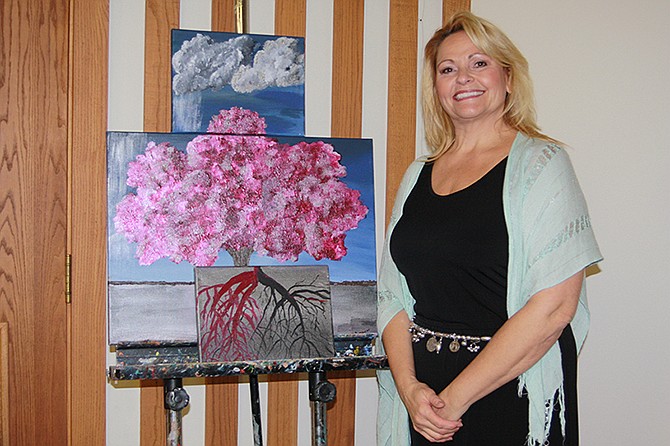Suzanne Miller's life changed irrevocably on July 28, 2013. At Thursday night's lecture at William Woods University, she told her audience how it changed and how she has coped since then.
In the years before the stroke, Miller was on the Parent-Teacher Organization board. She coached her kids' sports. She had a successful business where she helped students prep for the ACT, MCAT and LSAT.
"I am a huge, huge nerd," Miller said.
A little over a week before her stroke, Miller had a routine visit at the chiropractor's office - she had been visiting chiropractors regularly for the last eight or nine years. This time, the chiropractor decided to try and loosen her neck, which she'd never had done before.
"He was just - phah!" she said, making a wrenching gesture.
Miller was in incredible pain, cursing and hyperventilating. The chiropractor didn't stop.
She spent a week lying on the couch at home, hoping the pain would stop. Her vision was affected. But she hauled herself up to go to Chicago for her father's birthday - he had cancer, and she feared it might be his last birthday.
While she was there, her stoke hit.
When the paramedics arrived, it was obvious she'd had a stroke. She stumbled nonsensically through words. The paramedics gave her a shot of blood thinners to allow blood to reach her brain.
"My words got a little better after an hour, but eight hours later, I couldn't speak at all," she said. "My hands were up here, I was slobbery, the whole shebang."
Miller and her doctors later figured out that when her chiropractor had adjusted her neck, he had severely damaged her carotid artery. As it healed, it eventually shed two clots, a smaller one and a larger one. The larger one reached her brain last, when she couldn't be given any more blood thinners.
Miller showed a scan of her brain.
"The white part is dead," she said.
The white part affected the left hemisphere of her brain, and comprised part of her frontal lobe, most of her temporal lobe and about half of her parietal lobe. Most vitally, it encompassed the two parts of the brain that control speech: the Wernicke's and Broca's areas.
The damage to those areas caused aphasia, a condition that makes it difficult for a person to communicate. Depending on the areas affected, it may be difficult for them to process spoken or read words and to speak.
It took months of therapy before she could talk again. Four of those months were spent at the Rehab Institute of Chicago, doing therapy from 7 a.m. to 4 p.m. She also had to relearn how to walk - her control over the right side of her body was also damaged.
Now, three years later, she still has to pause and reach for words. She gets hung up on the letter S. Reading is tricky. Sometimes, her train of thought derails.
"I'm not going to give up on my left side yet," she said. "I miss my words."
The English section of the ACT had always been her favorite part. Today, she studies the dictionary every day and savors words like "corpus callosum" and "articulately."
The brain, Miller explained, is plastic. It adapts. Other parts take up lost functions. And it's very important to engage the parts that are undamaged.
For Miller, that was the right side of her brain, and she engages it with painting.
"I was getting some stuff for my kids from my basement, and I found some acrylic paints," she said. "I started messing around with them."
Before long, she was hooked. Her paintings feature symbolism: clouds for her brain, tree roots for arteries, the color pink for hope.
"Every picture that I've painted, I have hope," she said.
Along with her newfound creativity, Miller said engaging the right side of her brain has lead to other changes, as well.
"I've always been an intuitive person, but now I'm even more intuitive," she said.
Miller said she's met 17 other people who have experienced strokes caused by chiropractic manipulation. She regularly speaks about her experience in hopes of getting those dangers recognized.
"I believe it's my responsibility to tell people what happened," she said.
After a talk in Chicago, an audience member approached her, and Miller ended up showing off some of her paintings. The audience member turned out to own an art gallery and encouraged Miller to put on a show there.
"My first show was in March," Miller said. "I brought 40 paintings and sold 37."
Today, she's still doing therapy and firmly believes someday she'll be able to read again and speak with the sense of witty timing she remembers having.
"I would really like to have my words because I'm still the same person," Miller said.
Miller is also lobbying for aphasia to be recognized as a chronic condition. Currently, Medicaid treats it as an acute condition - meaning it only covers a limited amount of therapy. She also hopes to get the "pull, twist and thrust" technique, which damaged her carotid, outlawed.
She encouraged audience members to be patient if they meet another aphasiac.
"People with aphasia, we don't mean to be wrong or irritating, but we can be," she said. "If you ever meet someone who has aphasia, talk to them."

